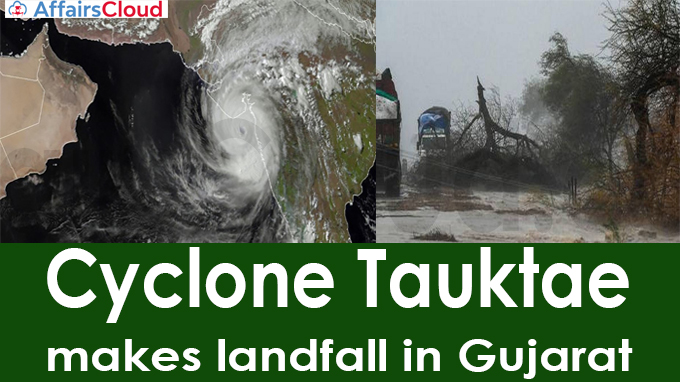 Indian Meteorological Department (IMD) stated that the ‘extremely severe cyclonic storm’ – ‘Tauktae’ made landfall in the Saurashtra region of Gujarat. The cyclone originated from the Arabian Sea.
Indian Meteorological Department (IMD) stated that the ‘extremely severe cyclonic storm’ – ‘Tauktae’ made landfall in the Saurashtra region of Gujarat. The cyclone originated from the Arabian Sea.
- The cyclone brought severe rains, winds of upto 150 -160 kmph & damages to the states of Gujarat, Maharashtra, Kerala, and Daman & Diu.
- The name ‘Tauktae’ for the cyclone has been given by Myanmar, It means ‘gecko’, a highly vocal lizard in Burmese dialect.
Origin of Cyclones
- Cyclones develop from a small depression or low air pressure area caused by temperature differences in the sea.
- Greater the temperature difference, greater the low pressure and stronger the cyclone.
Who names the Cyclones?
i.A global body led by the World Meteorological Organisation (WMO), UN Economic and Social Commission for Asia and Pacific (UN ESCAP), Regional Specialised Meteorological Centres (RSMC), and tropical cyclone warning centres prepare the names of the cyclone
ii.IMD is among the Six RSMCs in the world.
- It is mandated to issue advisories & name cyclones in the Northern Indian Ocean Region (IOR).
- A panel consisting of 13 countries – India, Bangladesh, Myanmar, Pakistan, the Maldives, Oman, Sri Lanka, Thailand, Iran, Qatar, Saudi Arabia, the United Arab Emirates and Yemen, names cyclones in the IOR.
iii.The next cyclone in IOR will be called ‘Yaas’, a name given by Oman.
Recent Related News:
On October 12, 2020 India Meteorological Department(IMD) launched a dynamic, impact-based cyclone warning system to reduce economic losses and damage to property caused by the cyclones that hit Indian coast annually.
About India Meteorological Department(IMD):
IMD is functioning under the Ministry of Earth Sciences(MoES), Government of India.
Headquarters – New Delhi, India
Director-General of Meteorology (DGM) – Mrutyunjay Mohapatra




